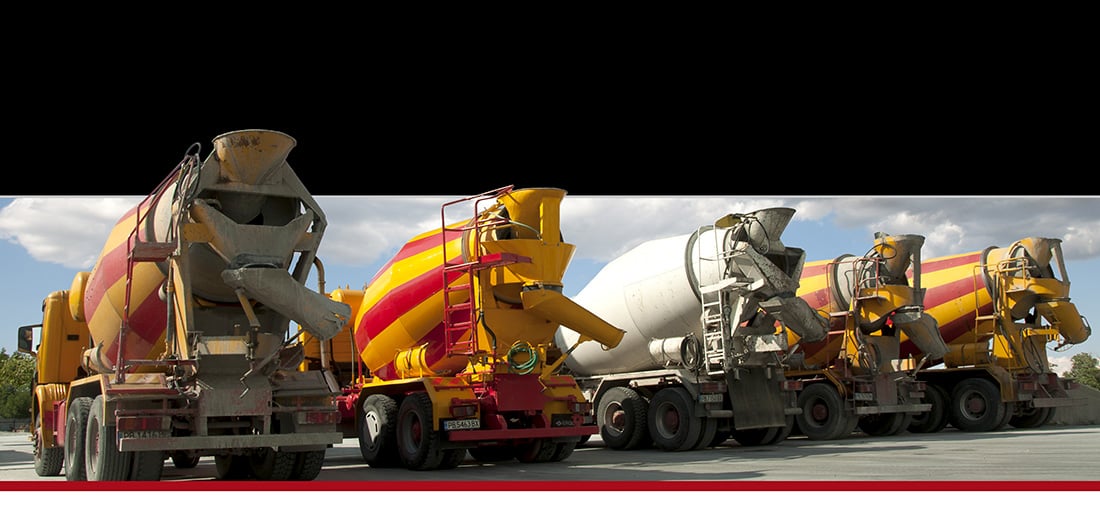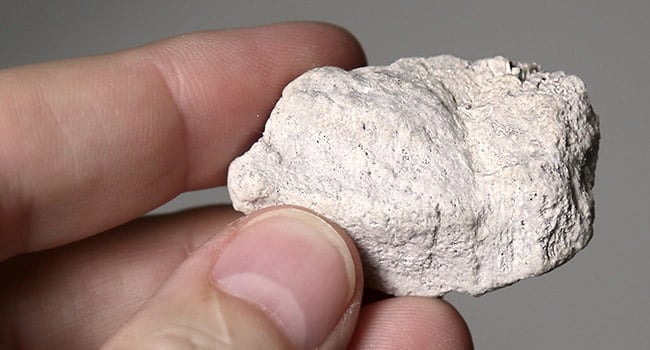
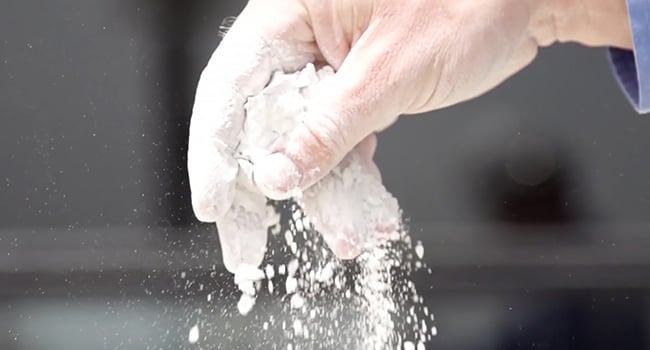
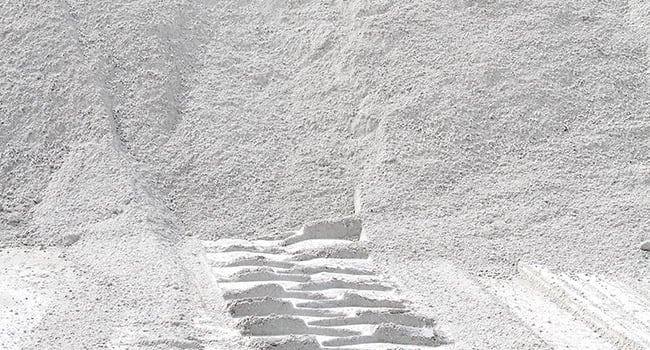
Foamed-stone pumice aggregate and performance-charging pumice pozzolan change the character, expand the utility, and improve the functional lifespan of concrete.
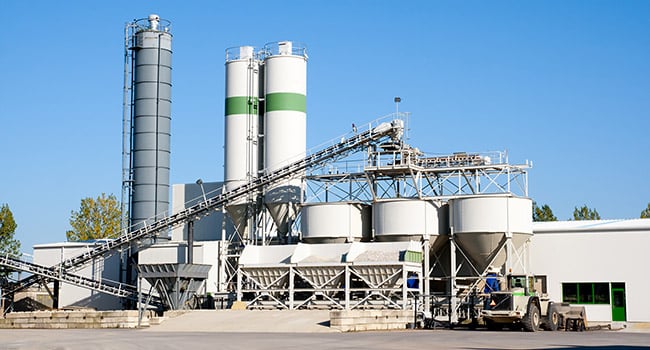
ABOVE (from top): Typical pumice stone from the Hess Pumice deposit in Southeast Idaho.
2 • Fine-ground pumice pozzolan powder (Hess Pozz Ultrafine).
3 • Pumice sand stockpile.
4 • Pumice concrete can be mixed and batched with the same equipment used for standard concrete, with some adjustments made to the process.
PUMICE AND CEMENT enjoy a dynamic and beneficial relationship—a relationship Roman engineers and builders relied on completely. A relationship that worked so well that much of their empire of concrete endures to this day—some 2000 years later. Fact is, the hydrated lime cement the Romans used made a poor concrete by itself. It was only after they added fine-grained pumice [01] (what they called pozzolana), did their concrete achieve its impressive millennia-spanning chemistry. They also employed frothy pumice aggregate when they wanted a lightweight concrete—for example, in the dome of the Pantheon[02]. Even today, in an industry dominated by modern quick-setting Portland cement, pumice still plays a key role in high-performance concretes.
Beyond the pozzolanic applications, pumice is an ideal lightweight aggregate for specialized form-placed or precast concrete applications that call for less weight and/or insulative qualities.
SPECIFICALLY, PUMICE IMPROVES AND/OR FUNCTIONALLY COMPLIMENTS CONCRETE AND CONCRETE PRODUCTS IN THE FOLLOWING WAYS:
Performance-Boosting Pozzolan
Today’s standard concretes simply aren’t as good as they could (and should) be: almost as soon as standard Portland cement concrete is placed, the process of degradation begins. Adding a high-purity natural pumice pozzolan to the concrete formulation mitigates or completely eliminates the problems inherent in standard concrete. ASTM-standards research has shown natural pumice pozzolan provides significant performance increases in terms of appearance, impermeability, longevity, thermal cracking, resistivity to chemical attacks, and compressive strength. [ MORE ]
Mitigate ASR with Pumice Blended Cement
Alkali-Silica Reaction (ASR) is a relentless infrastructure assassin—there is no way to stop it once such chemically-flawed concrete has been placed. ASR must be mitigated in the concrete mix design by specifying a consistent, quantifiable supplementary cementitious material (SCM) that flatlines the reaction. Clean, naturally calcined pumice from the massive Hess deposit in southeast Idaho USA is ideal: this carefully refined pumice not only delivers proven ASR mitigation in the presence of even highly reactive aggregates, it does so as a percentage of cement replacement while contributing additional durability benefits to the concrete. [ MORE ]
Lightweight Insulation Concrete
Pumice concrete has several advantages over conventional concrete in many construction applications—first, and perhaps most significantly, its unique lightweight quality. This trait contributes to a decrease in structural steel costs and, consequently, job costs. Larger volumes of concrete can be handled by lighter equipment with less wear and tear on that equipment. There is also a significant reduction of dead weight on supports and formwork. Second, pumice concrete has superior resistance to harsh weather conditions like freezing and thawing and an R-value some 4-times that of ordinary concrete—making pumice concrete suitable for colder climates and places that experience dramatic changes in the weather. Also, pumice concrete is a functionally ideal concrete for insulated concrete form (ICF) wall and decking systems. [ MORE ]
Precast Concrete Products
When precast concrete products need to be both lightweight and strong, pumice fits the spec—in the form of aggregate and sand (lightweight) and pozzolan powder (strength and durable density). [ MORE ]
Pumice-Crete®
Pumice-Crete® is a low density, lightweight, low-rise structural concrete using 3/8 pumice aggregate, Portland cement, and water. The honeycomb-like walls are formed and poured at a typical thickness of 18-24 inches, with no additional structural reinforcement[03] or insulation needed. Wall surfaces are finished inside and out with plaster (a breathable pozzolan lime plaster is ideal), further improving the thermal performance of the structure. [ MORE ]
Other Cementitious Applications
CEMENTITIOUS GROUT—Cement and pumice-blended ultrafine injection grouts are used to economically stabilize and strengthen weak soils and seal microfractures in rock and concrete structures against inflow or leachate. [ MORE ]
POZZOLANIC HYDRATED LIME (PHL) PLASTERS—A simple formulation of water + lime + pumice pozzolan not only out-performs modern plaster equivalents in terms of aesthetic appeal, flexiblity and breathability, it stands as an environmentally attractive alternative to synthetic stucco and other Portland cement-based products. [ MORE ]
GLASS FIBER REINFORCED CONCRETE (GFRC) PANELS—With GFRC surfacing panels, the balance between weight, strength, and durability is a delicate one—bright, hard, lightweight Hess pumice aggregate and Hess UltraPozz (superfine pumice pozzolan) make it all work to impressive advantage. [ MORE ]
LIGHTWEIGHT BLENDED MATERIALS—Stucco and bonding mortar products structured around the utility of lightweight pumice aggregates. [ MORE ]
FOOTNOTES
01—Deep underground, in the fiery heart of an awakening volcano, water mixes with molten rock, pressure builds...finally finding a violent, spectacular release. When it hits the atmosphere, the trapped water in the viscous, super-heated liquid rock flashes to steam, blasting the magma into a frothy stone that cools, hardens, and falls to the earth as pumice…a foamed-glass stone that is hard yet friable, non-crystalline in structure, and naturally calcined—a combination of characteristics that make pumice powders and aggregates incredibly useful to a variety of industries. [ MORE ABOUT PUMICE ]
02—More about the amazing concrete formulated by the Romans, including links to other informational sources. [ MORE ABOUT ROMAN CONCRETE ]
03—Check with local building codes and consult with a structural engineer.


